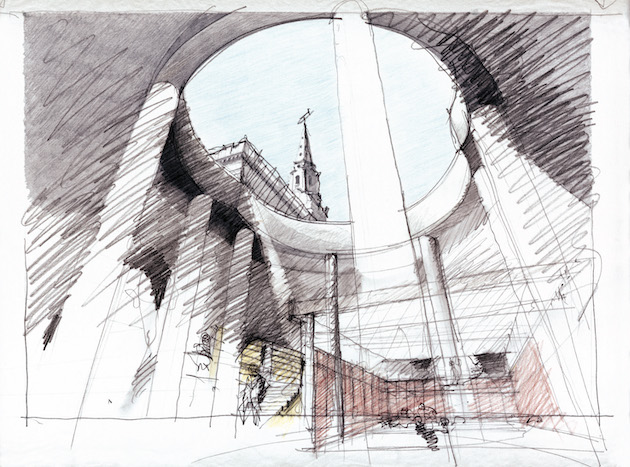 Holburne Museum of Art Bath. Copyright Eric Parry
Holburne Museum of Art Bath. Copyright Eric Parry
Eric Parry is a master draughtsman who urges fellow architects to theorise with their sketching pencil. For Parry, the drawing table is where the human potential of his projects – including the shimmering Holburne Museum extension in Bath and the weathered steel structure of 4 Pancras Square in north London – reveal themselves.
A new exhibition at the Sir John Soane’s Museum in London, Eric Parry: Drawing, collects dozens of Parry’s sketchbooks stretching back 40 years. Nestled like Easter Eggs between the Soane’s lavish collection, Parry’s sketchbooks and precise formal drawings display the skill of Parry’s observation and imagination. But, above all, they show how the architect turns over his projects’ possible futures, developing the ‘richness’ of social relations that have won them acclaim.
‘Architecture is a cultural activity,’ explains Parry. ‘To get a hand on why we build particular buildings for particular social activities, drawing is as important as anything in architecture – to understand that architecture is a framework for social engagement.’
‘Probably, the biggest reason for sketchbooks is that it’s a way of engaging with the world more broadly.’
The Soane’s exhibition splits Parry’s drawings into sections each referencing reasons why Parry remains committed to sketching by hand. Here, Parry explains to senior curator Owen Hopkins what these notebooks achieve.
Character
‘We don’t read a building in the abstract terms of proportion’, Parry observes, ‘but in the sense of its character’. The pages on show here illustrate Parry’s recurring interest in observing and documenting the character of people, buildings, places and cities. For him, ‘character is a way of making sense of the world’, of configuring what we feel through our senses into experiences that have meaning and value. Within these processes, ‘the subtlest of shifts can have an incredibly powerful effect, from the crease in a smile, or the shift of an eye, all the way up to the scale of the city’.
 Preliminary sketch of the lightwell at St Martins in the Fields London 2002. Copyright Eric Parry
Preliminary sketch of the lightwell at St Martins in the Fields London 2002. Copyright Eric Parry
Effect
The way we experience architecture – whether a room, building or even a city – emerges not just from their physical, material qualities but what we might understand as their effects – the way light and shadow fall over a series of surfaces, the reverberation of sound in a room, the smell of a timber floor. The latter are largely intangible and fleeting and shaped also by what we bring ourselves – our mood, memories and sensibilities. These pages show how in Parry’s hands drawing operates almost as an extension of this experience, conveying not just the visual field but the totality of the transient and immaterial effects of architecture.
Movement
Movement is inherent in drawing. The cumulative marks that constitute a drawing are made by a hand moving repeatedly across a page. And as an observational and analytical practice, a drawing is almost always a record of movement of some kind. ‘The question’, as Parry sees it, ‘is how to translate movement on to the page in a way that has a sense of rapidity, pacing and rhythm’.
 4 Pancras Square, north London. Copyright Eric Parry
4 Pancras Square, north London. Copyright Eric Parry
Listening
Parry’s sketchbooks contain not only drawings, but are full of notes; indeed, sometimes they are more notes than sketches. This illustrates that, for Parry, observing can be about listening as well as seeing. The pages on show here relate to various lectures and talks that Parry has attended over the years, often delivered by friends or colleagues.
Survey
Parry’s sketchbooks document his various travels over the years, visiting buildings and places and recording what he saw and what he thought of them. These depictions vary between the quick sketch and comparatively detailed survey drawing, depending on the importance and interest of the subject and the time available. Both approaches, however, reflect the capacity of drawing to act as a means of analysing what one sees, discerning the important from the incidental and, critically, putting it in relation to other experiences.
 30 Finsbury Square. Copyright Eric Parry
30 Finsbury Square. Copyright Eric Parry
Designing
Drawing is an act of synthesis. To make a mark on paper is the start of a process of discovery, of creation and of bringing something new into existence that did not exist before. This is the essence of designing and is maybe why drawing is so fundamental to architecture. As a drawing emerges from a page over time, so a building emerges from a site.
Building
Before it ever becomes about construction, building is a process of communication. For architects, this process extends within and beyond the bounds of their discipline, as designs and ideas are communicated, not just between colleagues, but to the client commissioning the building and to the builder who is putting it up. Drawing is fundamental to this process as the means of translation between different disciplines.


















